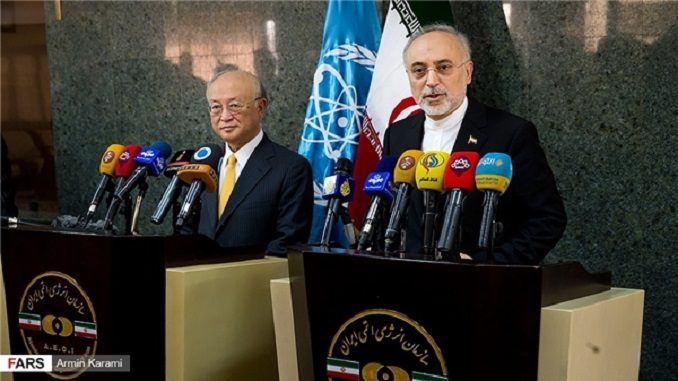
Iran’s nuclear program chief said Sunday that his country can begin producing weapons-grade nuclear material in just four days if the nuclear deal with foreign powers falls through, and insisted that international inspectors will not be given access to closed Iranian military sites.
Ali Akbar Salehi, the head of the Iranian Atomic Energy Organization, said that while Tehran prefers to keep the landmark nuclear agreement intact the Fordo site can quickly begin ramping up uranium enrichment.
“We can produce 20 percent (enriched uranium) at Fordo in four days but we don’t want the nuclear deal to collapse,” Salehi told reporters, according to an English translation of his comments provided by the semi-official Fars news agency.
He further warned that his organization enjoys the capability to boost uranium enrichment to 100 thousand SUVs in a matter of around a year if the deal is abrogated.
The Iranian atomic spoke to media after a joint press conference with the visiting director of the International Atomic Energy Agency, Yukiya Amano, in Tehran. Amano also met with Iranian President Hassan Rouhani and Iranian Foreign Minister Mohammad Javad Zarif. At the press conference, he said that Iran is complying with the terms of the nuclear deal.
Salehi also maintained that Iran’s military sites will remain off-limits to nuclear inspectors.
“We have spoken about the section T and our positions have been clearly declared,” he said, referring to the clause in the agreement that deals with inspections at Iranian facilities.
“The section T does not include any peculiar inspections. When the section T was being compiled, these considerations were taken into account but unfortunately, the other side is after its own interpretations.”
AEOI Spokesman Behrouz Kamalvandi underlined that the issue with the inspection of his country’s military sites ended forever after Tehran permitted the International Atomic Energy Agency (IAEA) to inspect Parchin in 2015.
“When there is no nuclear activity in a place, there is no reason to go there. They (the westerners) launched baseless propaganda in the international media in the past few years that certain activities were being carried out in Parchin site and finally, we were forced to end this issue once and forever and it happened and the case was closed and the IAEA’s Board of Governors also confirmed it,” Kamalvandi said.
Noting that inspection of military sites has been stated neither in the 2015 nuclear deal nor the Additional Protocol to the NPT and the IAEA safeguards agreement, he said that the UN nuclear watchdog can merely demand access to the centers in which nuclear activities are being conducted.
In July U.S. officials said the Trump administration was pushing for inspections of suspicious Iranian military sites in a bid to test the strength of the nuclear deal that Tehran struck in July 2015 with world powers.
The inspections are one element of what is designed to be a more aggressive approach to preventing Iran from obtaining a nuclear weapon. While the Trump administration seeks to police the existing deal more strictly, it is also working to fix what U.S. President Donald Trump’s aides have called “serious flaws” in the landmark deal that — if not resolved quickly — will likely lead Trump to pull out.
Earlier this month U.S. President Donald Trump decided to not recertify the deal, known as the Joint Comprehensive Plan of Action, saying the agreement had failed to curb Iran’s missile program and destabilizing activities in the Middle East.
The deal was signed by Iran and five permanent members of the United Nations Security Council establishing controls to prevent Tehran from developing an atomic bomb before the deal’s expiration in 2025. While Trump and Israeli officials have been very critical of the deal, the other partners have all indicated that they intend to uphold the pact.
An IAEA report released last month had also affirmed Iran’s compliance with the program, which froze some of Tehran’s nuclear activities.
In August, Salehi made a similar threat to Iran’s ability to restart uranium production. According to Israeli media reports, Iran needs about 240 kg of 20 percent enriched uranium to produce one atom bomb. IAEA reports in 2012, at a time when the nuclear deal was still being negotiated, found that Iran produced about 30kg of 20 percent enriched uranium during a period of three months.
Under the terms of the deal, Iran agreed to water down any uranium it possessed to below 5 percent purity.
